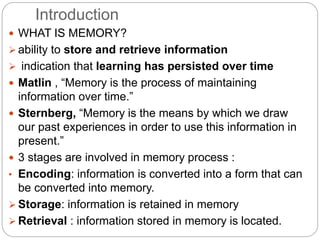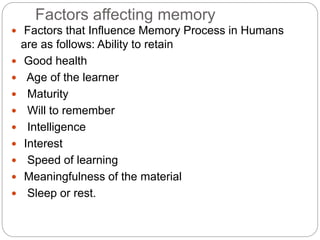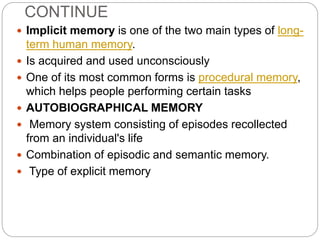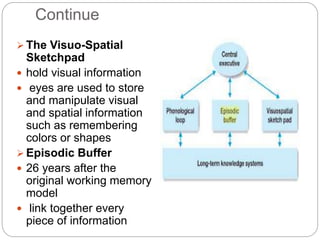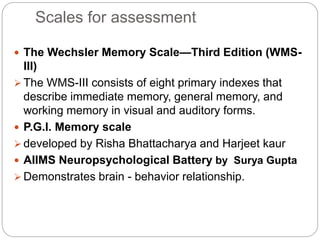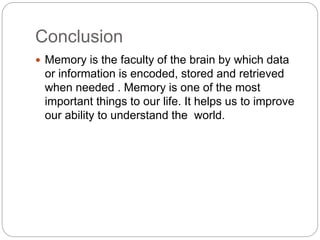Memory a mass of tissue formed as a res
- 1. Memory
- 2. Outline ’éŚ Introduction ’éŚ Types of memory ’éŚ George sperlingŌĆÖs experiment ’éŚ Working memory models ’éŚ Memory assessment ’éŚ Brain and memory ’éŚ Conclusion ’éŚ References
- 3. Introduction ’éŚ WHAT IS MEMORY? ’āś ability to store and retrieve information ’āś indication that learning has persisted over time ’éŚ Matlin , ŌĆ£Memory is the process of maintaining information over time.ŌĆØ ’éŚ Sternberg, ŌĆ£Memory is the means by which we draw our past experiences in order to use this information in present.ŌĆØ ’éŚ 3 stages are involved in memory process : ŌĆó Encoding: information is converted into a form that can be converted into memory. ’āś Storage: information is retained in memory ’āś Retrieval : information stored in memory is located.
- 4. Factors affecting memory ’éŚ Factors that Influence Memory Process in Humans are as follows: Ability to retain ’éŚ Good health ’éŚ Age of the learner ’éŚ Maturity ’éŚ Will to remember ’éŚ Intelligence ’éŚ Interest ’éŚ Speed of learning ’éŚ Meaningfulness of the material ’éŚ Sleep or rest.
- 6. Types of memory ’éŚ Sensory memory ’éŚ shortest-term element of memory. ’éŚ The ability to look at an item for a second and then remember what it looked like. ’éŚ processed approximately 200-500 milliseconds ’éŚ It is bought to us by our senses ’éŚ types of memory: ’éŚ Iconic memory ’āś Visual ’āś 100 ms ’éŚ Echoic memory ’āś sound ’āś 3-4 seconds
- 7. Short term memory ’āś It is temporary and short lived. ’éŚ Also called as recent memory/working memory. ’éŚ Retention time is longer than sensory memory. ’éŚ It may be long as 30 second or more. ’éŚ It has 3 main characteristics : ’āś Brief duration can only last upto 20 seconds ’āś Its capacity is limited to 7 plus minus 2 chunks of independent information (millerŌĆÖs law) and is vulnerable to interference and interpretation ’āś Its weakening (due to reasons such as medication, sleep deprivation, a stroke or head injury) and is the first step to memory loss.
- 8. LONG TERM MEMORY ’éŚ Durable or endless retention of the sensory impressions. ’éŚ Also called as permanent memory. ’éŚ The span of attention is better ’éŚ Identifying data like our name, parentage, date of birth, date of marriage, etc. ’éŚ Co relational with events and information. ’éŚ TYPES OF LONG TERM MEMORY ’āś Explicit memory ’āś Implicit memory EXPLICIT MEMORY ’éŚ It is the conscious, intentional recollection of factual information, previous experiences and concepts. ’éŚ Explicit memory can be divided into two categories: ’āś episodic memory, which stores specific personal experiences, and ’āś semantic memory, which stores factual information
- 9. Factors affecting episodic memory ’éŚ Retrieval cues : stimulus that are associated with information stored in memory and so can help bring the information to mind at times when it cannot be recalled spontaneously ’āś Context dependent memory :refers to the fact that information entered into memory in one context or setting is easier to recall in that context than in others ’āś State dependent retrieval : occurs when aspects of our physical states serve as retrieval cues for information stored in memory ’éŚ .
- 10. CONTINUE ’éŚ Implicit memory is one of the two main types of long- term human memory. ’éŚ Is acquired and used unconsciously ’éŚ One of its most common forms is procedural memory, which helps people performing certain tasks ’éŚ AUTOBIOGRAPHICAL MEMORY ’éŚ Memory system consisting of episodes recollected from an individual's life ’éŚ Combination of episodic and semantic memory. ’éŚ Type of explicit memory
- 11. George sperlingŌĆÖs experiment ’éŚ Showed a series of letters on a computer screen to participants. ’éŚ Letters were visible on the screen for a fraction of a second ’éŚ However, few were able to identify more than four or five letters. ’éŚ The results of these experiments suggested that the human visual system is capable of retaining information even if the exposure is very brief. The
- 12. Working memory models ’éŚ Atkinson and Shiffrin model
- 13. Alan Baddeley and Graham Hitch model ’éŚ Four components of this model ’āś Central executive: ’éŚ complete control of the actions of the other components ’éŚ ability to store information but its capacity is limited ’āś Phonological loop ’éŚ contains the articulatory control system (inner voice) and the phonological store (inner ear) - (not the physical ear canals) ’éŚ revives memory traces with all auditory information believed to directly enter the phonological store. ’éŚ An example of this involves people who hear their favorite music in their mind.
- 14. Continue ’āś The Visuo-Spatial Sketchpad ’éŚ hold visual information ’éŚ eyes are used to store and manipulate visual and spatial information such as remembering colors or shapes ’āś Episodic Buffer ’éŚ 26 years after the original working memory model ’éŚ link together every piece of information
- 15. Metacognition ’éŚ Metacognition refers to ŌĆ£thinking about thinkingŌĆØ and was introduced as a concept in by John Flavell, who is typically seen as a founding scholar of the field. ’éŚ Ability to control thinking processes through various strategies, such as organizing, monitoring, and adapting. ’éŚ considered a critical component of successful learning ’éŚ involves self-regulation and self-reflection of strengths, weaknesses, and the types of strategies you create ’éŚ Tip of the tongue(TOT) ’éŚ TOT phenomenon is the subjective feeling that people have of being confident that they know the target word for which they are searching, yet they cannot recall this word. ’éŚ They are somewhat able to recall words of similar sounds
- 16. Scales for assessment ’éŚ The Wechsler Memory ScaleŌĆöThird Edition (WMS- III) ’āś The WMS-III consists of eight primary indexes that describe immediate memory, general memory, and working memory in visual and auditory forms. ’éŚ P.G.I. Memory scale ’āś developed by Risha Bhattacharya and Harjeet kaur ’éŚ AIIMS Neuropsychological Battery by Surya Gupta ’āś Demonstrates brain - behavior relationship.
- 17. Brain and memory ’éŚ The hippocampus: transfers from short- to long-term memory and control of spatial memory and behaviour. ’éŚ The amygdala also performs a primary role in the processing and memory of emotional reactions and social and sexual behaviour, as well as regulating the sense of smell. ’éŚ MEMORY DISORDERS ’éŚ Normal ageing : Negative relation between age and performance test on memory ’éŚ Alzheimer disease: Poor retention and rapid forgetting. ’éŚ Frontal lobe dementia: occurs within the cortex , poor retention , organization, flexibility and ability sustain attention is disturbed and learning strategy are insufficient.
- 18. Continue ’éŚ Anterograde amnesia: the inability to store in long term memory information that occurs after an amnesia inducing event. Retrograde amnesia : loss of memory that occur prior to amnesia inducing event. ’éŚ Amnesic korsakoffŌĆÖs syndrome: inability to encode information and is caused by long term abuse of alcohol; often involves profound retrograde amnesia
- 19. Conclusion ’éŚ Memory is the faculty of the brain by which data or information is encoded, stored and retrieved when needed . Memory is one of the most important things to our life. It helps us to improve our ability to understand the world.
- 20. References ’é¦ Morgan, T.C., King, A.R., & Schopler, J.(1993).Introduction to psychology. India, New Delhi: Mc Graw hill education. ’é¦ Baron, A.R.,& Misra, G.(2002).Psychology. India, Delhi: Pearson. ’éŚ Pinel, J.P.J. (2000). Biopsychology (4th ed.).Boston: Allyn & Bacon.


